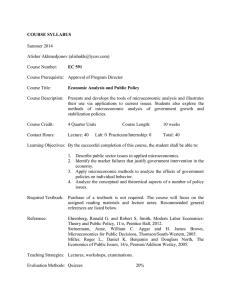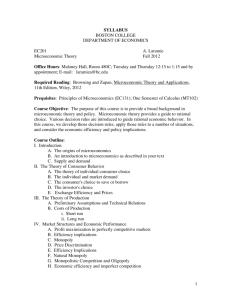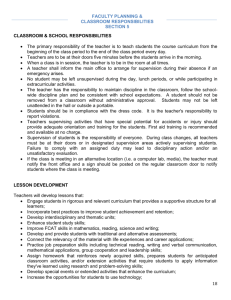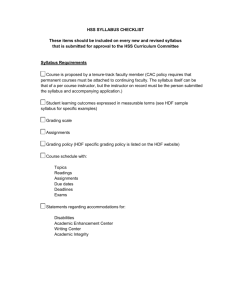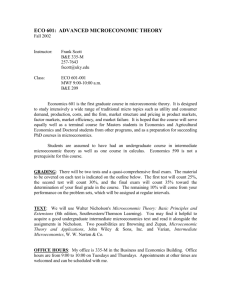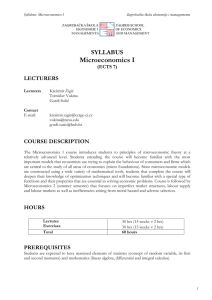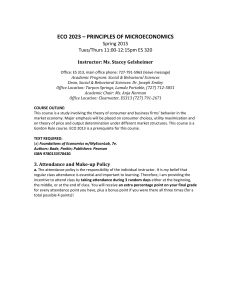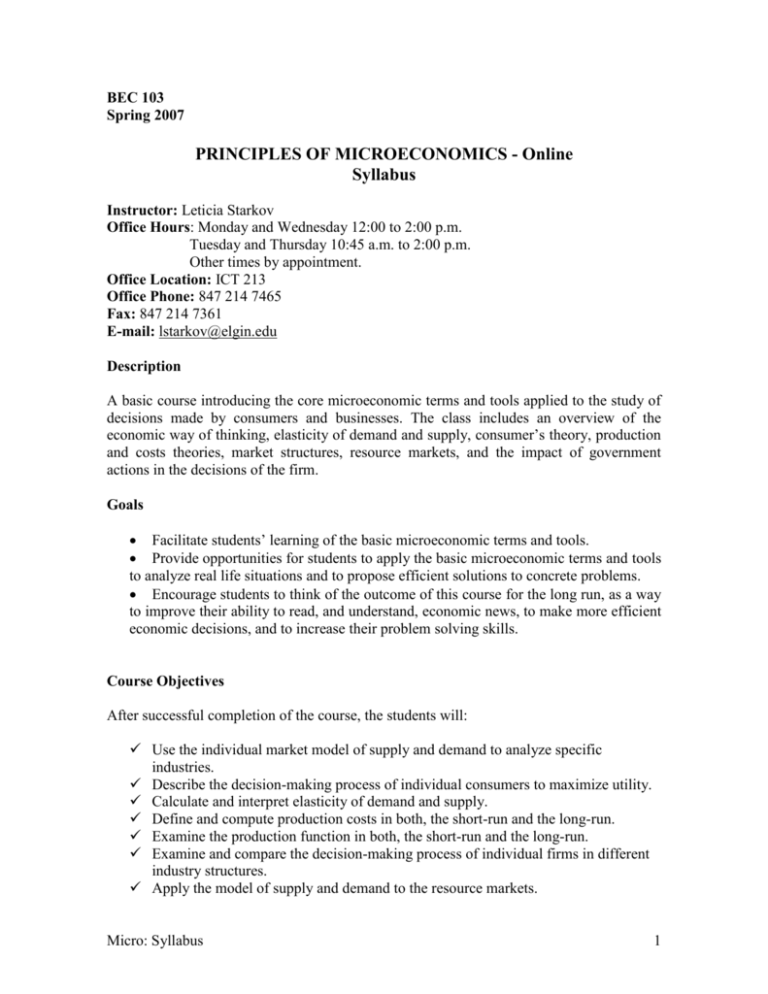
BEC 103
Spring 2007
PRINCIPLES OF MICROECONOMICS - Online
Syllabus
Instructor: Leticia Starkov
Office Hours: Monday and Wednesday 12:00 to 2:00 p.m.
Tuesday and Thursday 10:45 a.m. to 2:00 p.m.
Other times by appointment.
Office Location: ICT 213
Office Phone: 847 214 7465
Fax: 847 214 7361
E-mail: lstarkov@elgin.edu
Description
A basic course introducing the core microeconomic terms and tools applied to the study of
decisions made by consumers and businesses. The class includes an overview of the
economic way of thinking, elasticity of demand and supply, consumer’s theory, production
and costs theories, market structures, resource markets, and the impact of government
actions in the decisions of the firm.
Goals
Facilitate students’ learning of the basic microeconomic terms and tools.
Provide opportunities for students to apply the basic microeconomic terms and tools
to analyze real life situations and to propose efficient solutions to concrete problems.
Encourage students to think of the outcome of this course for the long run, as a way
to improve their ability to read, and understand, economic news, to make more efficient
economic decisions, and to increase their problem solving skills.
Course Objectives
After successful completion of the course, the students will:
Use the individual market model of supply and demand to analyze specific
industries.
Describe the decision-making process of individual consumers to maximize utility.
Calculate and interpret elasticity of demand and supply.
Define and compute production costs in both, the short-run and the long-run.
Examine the production function in both, the short-run and the long-run.
Examine and compare the decision-making process of individual firms in different
industry structures.
Apply the model of supply and demand to the resource markets.
Micro: Syllabus
1
Revise the impact of government policies in the decisions of individual firms.
Explain and analyze current events about specific firms and industries.
Apply the economic way of thinking and the microeconomic perspective to make
better economic decisions.
Required textbook
Bade, Robin, and Parkin, Michael. Foundations of Microeconomics, 3rd edition.
Pearson-Addison Wesley, 2007.
Course structure
The course is divided into six units. Each unit has two or more lessons. There are a total of
16 lessons that will be released weekly. Each lesson corresponds to one week of the 16week semester and must be completed in the correspondent calendar week. Each lesson has
learning objectives, assigned reading, class notes, a quiz, and an assignment to solve or a
discussion topic to participate in.
Course Outline
I. Introduction
1. The economic way of thinking
2. The U.S. economy and the rest of the world
3. The economic problem
4. Individual markets: demand and supply
II. A closer look at markets
5. Elasticities of demand and supply
6. Efficiency and fairness of markets
III. Microeconomics and government
7. Government influences on markets
8. Taxes, externalities, and public goods
IV. A closer look at decision makers
9. Consumer choice and demand
10. Production and cost
V. Industry structure
11. Perfect Competition
Micro: Syllabus
2
12. Monopoly
13. Monopolistic Competition
14. Oligopoly
VI. Microeconomics of the resource markets and international trade
15. Demand and supply in resource markets
16. International trade
Learning Resources
To successfully complete the class you must use the required textbook and access two main
websites: D2L and MyEconLab. The class work requires frequent use of these two
websites.
Workload
Students should plan to spend 6-10 hours a week working on the course. However, the time
commitment will vary depending on the students input, needs, and personal study habits.
Students are required to log in to the course a minimum of 3 times a week. Though, as
discussions develop, students may elect to log on more frequently.
Course Grades
Grading Points
Quizzes
Assignments
Mandatory discussions
Exams
Total
16%
20%
18%
46%
100
Grading Scale
89.5 and up
79.5 -89.49
69.5 - 79.49
59.5 - 69.49
59.49 and below
A
B
C
D
F
The grading policies above are final. I will not consider changing your final grade just
because you are “close” to the cutoff for the next letter grade. Each of the grading
instruments is explained in detail in the Course Set-up. Complete grades, the ones that take
into account all the class work you have done, will appear in the D2L website.
Final Note
I really would like for you to enjoy the course and even more important, for you to learn
useful ideas and analytical tools that may help you in future courses or in your everyday
decisions. I have a big responsibility in this task. I will do my part organizing the material,
choosing exercises, monitoring discussions, and providing class notes. However, your
Micro: Syllabus
3
participation is the most important ingredient to successfully finish the class. I strongly
suggest you to follow these tips in order to achieve the better results:
Read the book and class notes at least two times.
Practice answering questions and solving problems and quizzes in the textbook and in
MyEconLab.
Progress according to the calendar.
Do not leave it to the last minute. Economics is best learned in small regular doses
rather than trying to learn everything the night before taking the test.
Ask questions and get answers. According to my experience teaching Economics, that
is one of the most important rules of the game. Do not keep doubts. Make sure that you
truly understand the topics. You will be very welcome if you ask questions using email or phone. We can also meet in a time that is convenient for both. Avoid
getting lost in the course, asking questions when they appear or when the idea is
not clear enough.
Micro: Syllabus
4

